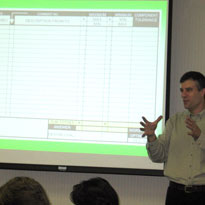LAN Systems and SONET/SDH
- Course:LAN Systems and SONET/SDH
- Course ID:SONET-LAN Duration:4 days Where: Your Office (7+ Persons)
- Download Course Description (PDF)
Available as a private, customized course for your group at your offices or ours and in some cases as a WebLive(TM) class.
Course Outline
- Course and Participant Introductions
- Course Overview
- Participant Introductions and Their On-the-job LAN and SONET/SDH Issues
- A Key Networking Concept: The OSI 7-Layer Architecture
- Where SONET/SDH Fits in the 7-Layer Structure
- Where Hubs, Switches, and Routers Fit in the 7-Layer Structure
- Understanding the SONET/SDH Technology
- SONET/SDH Frame Format Structure
- STS-1 Building Block
- STS-1 Frame Structure
- STS-1 Envelope Capacity
- Synchronous Payload Envelope (SPE)
- STS-N Frame Structure
- Overheads
- Section Overhead Line Overhead
- STS Path Overhead
- SONET/SDH Alarm Structure
- Pointers
- VT Mappings
- Concatenated Payloads
- Payload Pointers
- DS1 Visibility
- SONET/SDH Multiplexing
- SONET/SDH Synchronization and Timing
- Stratum Clock
- Plesiochronous Clock
- Overview of BITS
- SONET/SDH Network Elements
- Terminal Multiplexer
- Regenerator
- Add/Drop Multiplexer
- Protection and Survivability
- SONET/SDH Rings
- SONET/SDH Network Topologies and Configurations
- Point-to-Point
- Point-to-Multipoint
- Hub Architecture
- Ring Architecture
- Span Engineering
- Engineering a SONET/SDH and DWDM Link
- What are the Factors?
- Amplifier Power
- Amplifier Spacing
- Fiber Types
- Managing SONET/SDH Networks and Services
- Customer and Carrier Advantages
- OAM&P
- Multi-vendor Interoperability and Management
- Event Management
- Performance Management
- SONET/SDH Frame Format Structure
- Transmission Characteristics
- Path Terminating Equipment
- Line Terminating Equipment
- Section Terminating Equipment
- Section Overhead: Error Checking and Synchronization
- Line Overhead: Pointers and Protection Switching
- Path Overhead: Payload Management
- Concatenation
- Section
- Line
- Path
- Terminal, Repeater, ADM (Add Drop Mux), Ring
- LAN Systems
- The OSI 7-Layer Stack Revisited
- Application Layer
- Presentation Layer
- Session Layer
- Transport Layer
- Network Layer
- Data Layer
- Physical Layer
- Introduction to Ethernet – Layer 2
- Where the Equipment Fits in the OSI 7-Layer Model
- Hubs – Physical
- Switch – Data Layer
- Router – Network Layer
- The OSI 7-Layer Stack Revisited
- Discussion of Client-specific Equipment
- Laboratory Work
- Course Wrap-up and Post-evaluation
- Review of the OSI 7-Layer Model
- Review of the SONET/SDH Technology
- Review of LAN Systems
Course in a Nutshell
We created this course to meet the needs of technicians tasked with the important job of maintaining facilities from traditional copper to state-of-the-art fiber optic technology. An intensive four-day program, it consists of two days of classroom training and two days of laboratory work. The lab exercises are designed to simulate the actual field environment as much as possible.
Customize It!
We can customize this course, usually at little to no additional cost, to your network architecture and participant requirements.
Learn How To
- Explain the SONET/SDH technology
- Describe the SONET/SDH transmission hierarchy
- Explain digital signal synchronization
- List the SONET/SDH network elements
- Summarize the components of a fiber optic SONET link
- Explain protection switching
- Perform validation testing and troubleshooting using lab equipment
How You Will Learn
This is a workshop (lecture and hands-on lab) course. You will learn from a telecom expert with 25+ years of hands-on field expertise.
Aimed At
This course is aimed at field technicians who support the infrastructure and services for the client telecommunications system.
Prerequisites
The participants should have a basic knowledge of their network architecture, troubleshooting procedures, and measurement, repair, and validation techniques.
- Liked the way this course went from A to Z. Good participant handbook. Instructor made learning this material fun. Great instructor!

